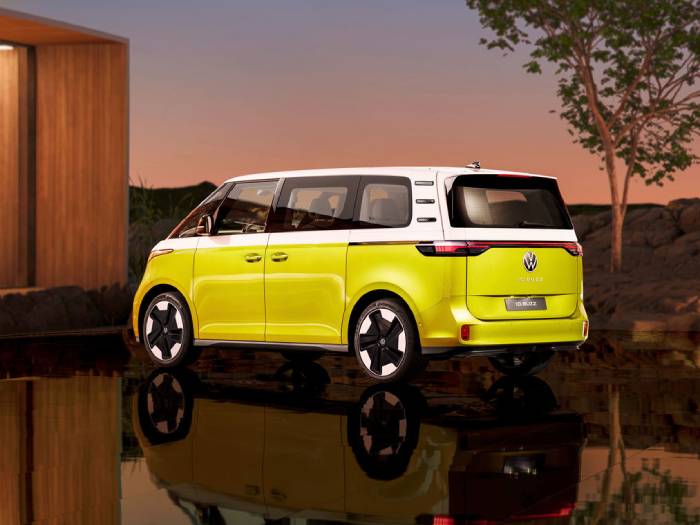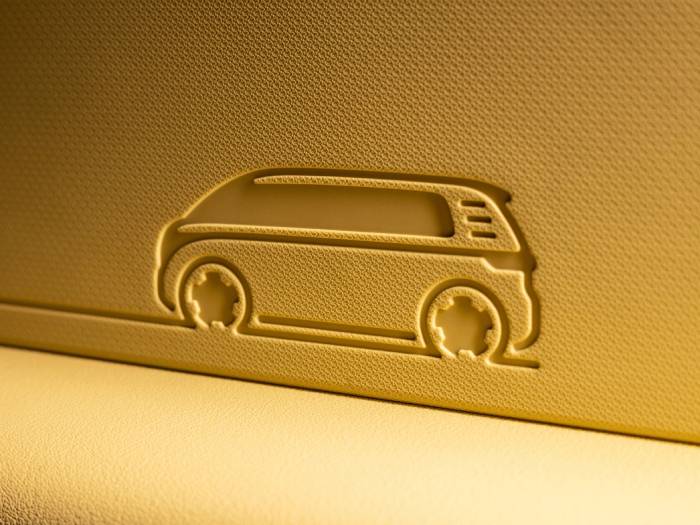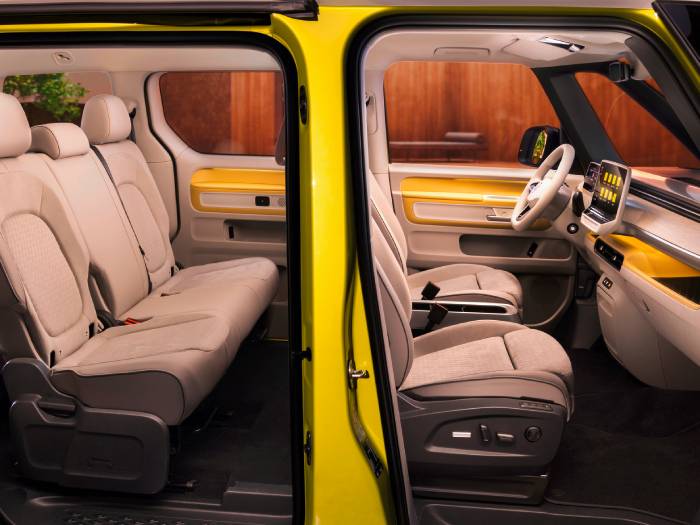ID. Buzz, zero emissions and the DNA of an icon
The Bulli is back, in an updated version: all-electric drive and high connectivity meet established features such as functionality and versatility that have made the Volkswagen T1 one of the most popular models worldwide since the 1950s.
The time has come: on 9th March, the Volkswagen ID. Buzz was unveiled in a world premiere. Inspired by the historic T1 - also known as Bulli - the new model brings the design of one of the greatest automotive icons into the age of e-mobility. The first range of all-electric vans and transporter (in addition to the ID. Buzz, the ID. Buzz Cargo will also be available) to be produced and distributed to customers on a CO2-neutral basis will hit the road this autumn.
Based on the MEB, in Europe the ID. Buzz will be available with a 77 kWh battery and will feature the latest technologies: latest-generation software and driver assistance systems, ultra-high connectivity, Over-the-Air updates, Plug & Charge for an even more comfortable charging procedure and bi-directional charging. Thanks to this latter, the ID. Buzz will be able to feed extra, unneeded energy from the battery into the home network (Vehicle-to-Home), with the possibility in the future of also supplying electricity to stabilise the grid. An epic breakthrough that takes the Bulli into a new dimension.
A mobility icon
"Icon” is a term that is often overused - in reality, there are only a few true icons. Any examples? The minimalist industrial products from Braun and Apple, the elegant “Danish Design” lamps of Poul Henningsen or the Bauhaus style of architecture and design. When it comes to cars, the Bulli is an icon. But to really understand what this means, it’s necessary to take a look at its history and delve into non-automotive disciplines.
Dieter Rams is one of the leading industrial designers and is known and appreciated worldwide. He designed iconic products for Braun, including the T3 pocket radio in 1968, which also inspired Apple 40 years later to use it as the basis for the first iPod. According to Rams, a design object must be innovative, functional, aesthetic, user friendly, well thought out and environmentally friendly. This philosophy is exemplified in Rams' approach to design: 'Less but better'.
The importance of functionality
In modern mobility, this means that cars should also be functional and able to adapt to change - and this is precisely the case with the new ID. Buzz1. The hi-tech Bulli, equipped with the latest generation of software, is able to update itself without even entering the service station, thanks to Over-the-Air connectivity. All this combined with a state-of-the-art user experience, characterised by a strong essentiality and high usability. The words of Poul Henningsen, the inventor of the PH5 lamp for Louis Poulsen in 1958, sum up the process from which the new ID. Buzz was born: “The future happens, progress doesn't”.
Icons mark the rhythm of time

In conclusion, icons are durable, high-quality products in which functionality and aesthetics go hand in hand - a description that fits perfectly with the Volkswagen T1, or Bulli, as it is affectionately known to its fans.
But why has it become one of the most legendary models in Volkswagen's history and in the automotive world? Because the Bulli combines versatility, a feeling of freedom and maximum use of space with a minimal footprint. A design philosophy also shared by the world-famous architect and founder of the Bauhaus school, Walter Gropius: "Architecture should reflect life and times". And this concept is also applied in the new ID. Buzz, which is ready to become an ideal companion in everyday life, in every situation - no matter if it is business or leisure time.
An electric van for everyone
The new ID. Buzz combines and expands recent automotive trends and features of the historic Volkswagen T1 van into a versatile and functional Bulli powered by an electric motor. Of course, compared to the 1950s, there are different requirements for a "minibus for everyone": the ID. Buzz is intelligently connected to its environment and boasts a range of assistance and information systems that are essential to provide the high technical level required for autonomous driving.
As mentioned, software updates are carried out in Over-the-Air mode; batteries are recharged via the Plug & Charge function, simply by plugging the vehicle into the charging station - so there is no need for additional steps for authentication via the app.
Attention to detail

In addition to maximum internal functionality, the ID.Buzz has been designed with great attention to detail. One small example, which brings the T1 to mind, are the stylised silhouettes of the ID. Buzz, imprinted in the side trims and seat linings.
Another aspect that recalls the past are the many aesthetic references, starting with the front seats practically on the front axle, with no overhang at the front, and the unmistakable front with its V shape between the sharply defined headlamps.
But is that enough to become an icon? An icon is something definitive and universal. If we step away from the world of automobiles for a moment and take a look at the field of architecture, what often makes a city so distinctive is its skyline; we can identify some cities by individual buildings, such as the Eiffel Tower and the Sacré Coeur in Paris or Big Ben in London. No matter whether we are talking about consumer goods, technical products or architecture, there are also clear parallels with the Bulli: the design of these structures is so extraordinary and expressive that it is unique, difficult to be improved upon. However, it is possible to develop a number of details without compromising the basic concept - which is also the main characteristic of the Volkswagen T1 van over the various generations. All this can be found in the ID. Buzz thanks to the work done by the designers.
Electric icon of the digital and connected age

With the ID. Buzz, Volkswagen expresses its focus on electromobility, digitalisation, connectivity, autonomous driving and new mobility and transport systems. All these elements come together in the new electric van, the most emotional member of the ID family.
Very close, in its final form, to the concept study that aroused great enthusiasm around the world, the ID. Buzz becomes a synonym for freedom more than any other vehicle. "The ID. Buzz is timeless and sustainable, while also being extremely functional, which is what makes it unique. But we were also very intentional, so as not to simply build another T1," says Jozef Kabaň, Head of Design at Volkswagen.
A piece of history on four wheels
The ID. Buzz reflects the images of a grand history, stretching from the German economic miracle to the flower power movement, to one of the most successful series of vans in Europe: the T1 - an icon of the 1950s - which was the symbol of democratisation of mobility and freedom. "With the ID. Buzz, we are transferring the DNA of the T1 to the present day, and thus to the era of electromobility and sustainability," explains Kabaň.
At the same time, with its unique DNA, it is the world's first electric van and transporter in its class to be developed on a modular platform designed exclusively for zero-emission vehicles - a perfect summary of an evolving mobility that is moving towards a sustainable, connected and digitalized future.
1) Prototype close to production, not yet for sale
Source: Volkswagen - Shaping Mobility Hub
VGI | Responsible OU: VP | Creation date: article date | Class 9.1